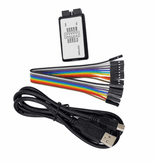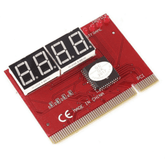Explore 5 Must-Try Raspberry Pi Projects in 2025 for Beginners
Project 1: Finger Counting Project Using Raspberry Pi

Introduction:
Experience the power of technology with this Finger Counting Raspberry Pi Project! This Raspberry Pi based project uses computer vision to count fingers in real time. It's a fun and practical application of machine learning and image processing.
Concept and Purpose:
The concept involves utilizing image processing and machine learning to detect and count fingers using a camera feed. The purpose is to demonstrate the capabilities of real-time computer vision for innovative applications in education and entertainment.
Components and Tools Needed:
- Raspberry Pi
- Camera
- Python with OpenCV and MediaPipe libraries
Connections:
No additional hardware is required for this Raspberry project. Simply connect a USB camera to your Raspberry Pi and run the Python script.
Code:
import cv2
import numpy as np
# Start video capture
cap = cv2.VideoCapture(0)
while True:
ret, frame = cap.read()
hsv = cv2.cvtColor(frame, cv2.COLOR_BGR2HSV)
# Create a mask for skin detection
lower_skin = np.array([0, 20, 70], dtype=np.uint8)
upper_skin = np.array([20, 255, 255], dtype=np.uint8)
mask = cv2.inRange(hsv, lower_skin, upper_skin)
# Find contours
contours, _ = cv2.findContours(mask, cv2.RETR_TREE,
cv2.CHAIN_APPROX_SIMPLE)
if contours:
max_contour = max(contours, key=cv2.contourArea)
hull = cv2.convexHull(max_contour, returnPoints=False)
defects = cv2.convexityDefects(max_contour, hull)
if defects is not None:
finger_count = defects.shape[0] + 1 # Count fingers
cv2.putText(frame, f"Fingers: {finger_count}", (50, 50),
cv2.FONT_HERSHEY_SIMPLEX, 1, (0, 255, 0), 2)
cv2.imshow("Finger Counter", frame)
if cv2.waitKey(1) & 0xFF == ord('q'):
break
cap.release()
cv2.destroyAllWindows()
Conclusion
This beginner-friendly Raspberry Pi project is an excellent introduction to electronics and programming with Raspberry Pi.
Project 2: Home Automation Project using Raspberry Pi

Introduction:
Transform your home into a smart haven with the Raspberry Pi Home Automation Project! Control lights, fans, and appliances through a web interface or voice commands.
Concept and Purpose:
The Raspberry Pi smart home projects demonstrate how to use Raspberry Pi for IoT-based home automation, enabling users to remotely control devices via a simple web application.
Components and Tools Needed:
- Raspberry Pi
- Relay module
- Electrical appliances (e.g., light bulb)
- Flask (Python library)
Connections:
- Connect a relay module to GPIO pin 18.
- Attach the relay to the appliance to control.
Code:
from flask import Flask, render_template, request
import RPi.GPIO as GPIO
# Setup
app = Flask( name )
GPIO.setmode(GPIO.BCM)
GPIO.setup(18, GPIO.OUT) # Pin 18 for controlling the relay
@app.route('/')
def home():
return render_template('index.html')
@app.route('/turn_on')
def turn_on():
GPIO.output(18, GPIO.HIGH) # Turn on the appliance
return render_template('index.html', message="Appliance Turned ON")
@app.route('/turn_off')
def turn_off():
GPIO.output(18, GPIO.LOW) # Turn off the appliance
return render_template('index.html', message="Appliance Turned OFF")
if name == ' main ':
app.run(host='0.0.0.0', port=5000, debug=True)
Conclusion
This Raspberry Pi IoT project provides a foundational understanding of IoT and how Raspberry Pi can be used to create a smart home setup.
Project 3: Smart Surveillance Camera Using Raspberry Pi

Introduction:
Secure your space with the Smart Surveillance Camera Raspberry Pi project. This Raspberry Pi based system streams video and detects motion, notifying you instantly.
Concept and Purpose:
The project helps you to build your own security system with Raspberry Pi, which focuses on real-time video streaming and motion detection, offering an affordable and customizable surveillance solution. Components and Tools Needed:
- Raspberry Pi
- USB Camera
- Python with OpenCV
- (Optional) PIR motion sensor
Connections:
Connect a USB camera to your Raspberry Pi. Optionally, integrate motion sensors for advanced functionality.
Code:
import cv2
import RPi.GPIO as GPIO
import time
# Set up GPIO
GPIO.setmode(GPIO.BCM)
PIR_PIN = 17 # Set the GPIO pin for motion sensor
GPIO.setup(PIR_PIN, GPIO.IN)
# Initialize camera
camera = cv2.VideoCapture(0) # Use the first available camera
while True:
if GPIO.input(PIR_PIN): # If motion is detected
print("Motion Detected!")
# Start video capture
ret, frame = camera.read()
if ret:
# Display the captured frame
cv2.imshow("Surveillance Feed", frame)
# Wait for 3 seconds before taking another image
time.sleep(3)
else:
print("No motion detected.")
time.sleep(1) # Check every second for motion
# Break loop when 'q' is pressed
if cv2.waitKey(1) & 0xFF == ord('q'):
break
camera.release()
cv2.destroyAllWindows()
GPIO.cleanup()
Conclusion
This Raspberry Pi 4 project is a cost-effective way to enhance security at home or in the workplace. It is easy to set up and extend with additional features like alerts.
Project 4: DIY Traffic Light Project

Introduction:
Learn how traffic lights work by building your own system using Raspberry Pi. This project is perfect for understanding GPIO control. This is the best Raspberry Pi project for beginners
Concept and Purpose:
The project uses LEDs to simulate traffic lights, teaching the basics of GPIO programming and timing control.
Components and Tools Needed:
- Raspberry Pi
- LEDs (Red, Yellow, Green)
- Resistors (220 ohms)
- Breadboard and jumper wires
Connections:
- Connect LEDs to GPIO pins 18, 23, and 24 using resistors.
- Power the circuit with the Raspberry Pi.
Code:
import RPi.GPIO as GPIO
import time
# Set up GPIO
GPIO.setmode(GPIO.BCM)
# GPIO pins for LEDs
red_pin = 18
yellow_pin = 23
green_pin = 24
# Set up LEDs as output
GPIO.setup(red_pin, GPIO.OUT)
GPIO.setup(yellow_pin, GPIO.OUT)
GPIO.setup(green_pin, GPIO.OUT)
def traffic_light_sequence():
while True:
GPIO.output(red_pin, GPIO.HIGH) # Turn Red on
time.sleep(3) # Wait for 3 seconds
GPIO.output(red_pin, GPIO.LOW) # Turn Red off
GPIO.output(yellow_pin, GPIO.HIGH) # Turn Yellow on
time.sleep(1) # Wait for 1 second
GPIO.output(yellow_pin, GPIO.LOW) # Turn Yellow off
GPIO.output(green_pin, GPIO.HIGH) # Turn Green on
time.sleep(3) # Wait for 3 seconds
GPIO.output(green_pin, GPIO.LOW) # Turn Green off
GPIO.output(yellow_pin, GPIO.HIGH) # Turn Yellow on
time.sleep(1) # Wait for 1 second
GPIO.output(yellow_pin, GPIO.LOW) # Turn Yellow off
try:
traffic_light_sequence()
except KeyboardInterrupt:
pass
Conclusion
This beginner-friendly Raspberry Pi project is an excellent introduction to electronics and programming with Raspberry Pi.
Project 5: Air Quality Monitoring using Raspberry Pi

Introduction:
Stay informed about the air you breathe with the Air Quality Monitoring
Project. Use sensors and a Raspberry Pi to measure and display air quality in real time.
Concept and Purpose:
The project measures temperature, humidity, and air quality, offering insights into environmental conditions for health and safety purposes.
Components and Tools Needed:
- Raspberry Pi
- DHT11 sensor
- Resistors (10k ohms)
- Jumper wires
Connections:
- Connect a DHT11 sensor to GPIO pin 4.
- Use a 10k resistor between the data pin and VCC.
Code:
import Adafruit_DHT
import time
# Set up the DHT11 sensor
DHT_SENSOR = Adafruit_DHT.DHT11
DHT_PIN = 4 # GPIO pin where the sensor is connected
# Read the temperature and humidity from the DHT11 sensor
def read_air_quality():
humidity, temperature = Adafruit_DHT.read(DHT_SENSOR, DHT_PIN)
if humidity is not None and temperature is not None:
print(f'Temperature: {temperature}C Humidity: {humidity}%')
else:
print("Failed to retrieve data from the sensor")
while True:
read_air_quality() # Read and display air quality data
time.sleep(2) # Update every 2 secondsConclusion
This project is a great way to monitor and understand your environment. It is easy to implement and has practical applications.
Conclusion
These latest cool Raspberry Pi projects for 2025 are just the beginning of what you can create! Whether you're exploring AI, IoT, or home automation, each project helps you develop hands-on skills and bring ideas to life. So, grab your Raspberry Pi, experiment, and innovate—because the future of tech is in your hands!






